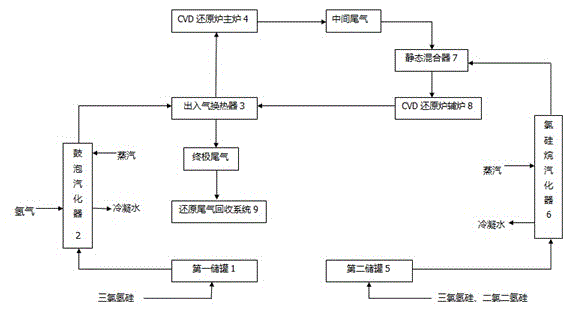Polysilicon production technology
A production process and polysilicon technology, applied in silicon and other directions, can solve the problems of increasing production costs, increasing the workload of the exhaust gas recovery system, affecting the service life of the whole system, etc., to reduce the generation rate, improve the service life, and inhibit the decomposition reaction effect.
- Summary
- Abstract
- Description
- Claims
- Application Information
AI Technical Summary
Problems solved by technology
Method used
Image
Examples
Embodiment 1
[0032] Refined trichlorosilane and hydrogen are mixed in the bubbling vaporizer 2 at a molar ratio of 4:1. By controlling the pressure and temperature of the bubbling vaporizer 2, the generated raw gas is sent to the inlet and outlet gas heat exchanger 3. The purity of refined trichlorohydrogen is greater than 99.99%.
[0033] The raw material gas entering the inlet and outlet gas heat exchanger 3 exchanges heat with the high-temperature final tail gas from the auxiliary furnace 8 of the CVD reduction furnace, which not only increases the temperature of the raw gas but also reduces the temperature of the final tail gas.
[0034] After the raw material gas is heated by the final tail gas from the auxiliary furnace 8 of the CVD reduction furnace, it continues to enter the main furnace 4 of the CVD reduction furnace, and reacts on the surface of the silicon core at 1125°C in the main furnace 4 of the CVD reduction furnace to form polysilicon. The by-products of the main furnace 4...
Embodiment 2
[0050] This embodiment is basically the same as Embodiment 1, except that the refined trichlorosilane stored in the first storage tank 1 is mixed with hydrogen gas in a molar ratio of 3:1 in the bubbling vaporizer 2 . The refined trichlorosilane and dichlorodihydrosilane stored in the second storage tank 5 are mixed in a molar ratio of 25:1. The intake air volume of the raw material gas in the main furnace 4 of the CVD reduction furnace is determined according to the diameter of the silicon rod, and is gradually increased from 175m / h to 32300m / h, and the inlet temperature of the main furnace 4 of the CVD reduction furnace is gradually increased from 51°C to 313°C. It can meet the minimum supersaturation of cauliflower material that does not grow on silicon rods, so it will not cause the phenomenon of melting cores of silicon rods.
[0051] In the generated intermediate tail gas, the content of dichlorodihydrosilane is 6%, and the unreacted refined trichlorosilane accounts for ...
Embodiment 3
[0054] This embodiment is basically the same as Embodiments 1 and 2, except that the refined trichlorosilane stored in the first storage tank 1 is mixed with hydrogen gas in a molar ratio of 3.5:1 in the bubbling vaporizer 2 . The refined trichlorosilane and dichlorodihydrosilane stored in the second storage tank 5 are mixed in a molar ratio of 22:1. The intake air volume of the raw material gas of the main furnace 4 of the CVD reduction furnace is determined according to the diameter of the silicon rod, and gradually increases from 197m / h to 32587.5m / h, and the inlet temperature of the main furnace 4 of the CVD reduction furnace gradually increases from 53°C to 331°C. This can meet the minimum supersaturation of the cauliflower material that does not grow on silicon rods, so it will not cause the melting of silicon rod cores.
[0055] In the generated intermediate tail gas, the content of dichlorodihydrosilane is 7%, and the unreacted refined trichlorosilane accounts for abou...
PUM
 Login to View More
Login to View More Abstract
Description
Claims
Application Information
 Login to View More
Login to View More - R&D
- Intellectual Property
- Life Sciences
- Materials
- Tech Scout
- Unparalleled Data Quality
- Higher Quality Content
- 60% Fewer Hallucinations
Browse by: Latest US Patents, China's latest patents, Technical Efficacy Thesaurus, Application Domain, Technology Topic, Popular Technical Reports.
© 2025 PatSnap. All rights reserved.Legal|Privacy policy|Modern Slavery Act Transparency Statement|Sitemap|About US| Contact US: help@patsnap.com

